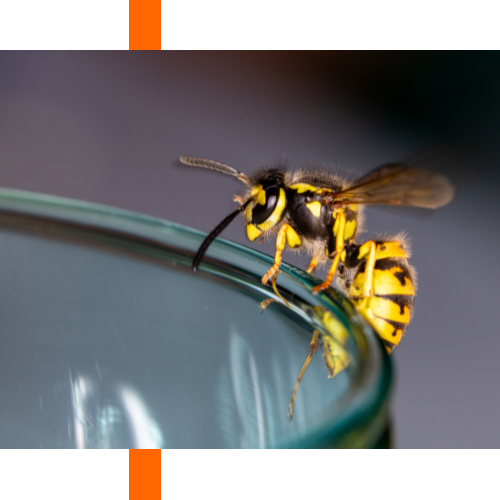
Stinging Insect Removal And Control
In the bustling state of New York, residents and business owners face many challenges, not least of which comes from the air - the common presence of stinging insects such as wasps, hornets, and yellow jackets. These insects are not just summer nuisances; they are persistent, widespread, and pose significant risks and discomforts to urban and suburban landscapes. From the green parks in the heart of the city to the quieter suburban backyards, these stinging insects make their presence known, building nests in places that bring them into frequent contact with humans and pets.
The Silent Threat
Wasps stand out due to their slender bodies and pronounced waists. They are known for their diverse nesting locations, which can range from under eaves to within attics or other sheltered areas, and for their unique behavior of not necessarily being aggressive unless provoked. The primary indicators of a wasp presence include visible nests, which are often papery and umbrella-shaped, and increased activity around homes and gardens. Despite their less aggressive nature compared to other stinging insects, wasps can sting multiple times, posing risks of painful stings and allergic reactions, especially in sensitive individuals.
Hornets, particularly the larger species found in New York, are known for their impressive size and complex social structures. They construct large, intricate paper nests that can house vast numbers of individuals, typically located in trees or shrubs, and sometimes on buildings. Hornets are drawn to both high-protein foods and sweet substances, which can lead them into human habitation areas, especially during outdoor activities. The risk hornets pose to homeowners is significant; they become highly aggressive when their nests are disturbed, potentially attacking anyone in close proximity. The potential for large nests in secluded areas adds a layer of difficulty in detecting and safely removing them without professional help.
Yellow Jackets are easily recognized by their striking yellow and black markings and are notorious for their aggressive behavior, particularly when their nests, often located underground, are disturbed. The indications of a yellow jacket infestation include sightings of foraging workers and the presence of nest entrances on the ground. These insects become particularly problematic in late summer and fall when their numbers peak and their search for food becomes more aggressive. The threat level posed by yellow jackets is considerable; their inclination to attack in groups can result in multiple stings to humans and pets, making them a formidable pest during the warmer months. The location of the nest adds another element of danger as people can unknowingly step right into one.
The Complex World Of Stinging Insects
- Remarkable Speed: Hornets are among the fastest flying insects, capable of reaching speeds up to 25 miles per hour. This agility allows them to evade predators, capture prey, and respond quickly to threats to their nests. Their ability to maneuver with precision makes them formidable hunters and challenging pests to manage without professional help. This speed is not just a defense mechanism but a key aspect of their survival and hunting strategies, enabling them to outmaneuver other insects and secure food for their colonies.
- Predatory Behaviors: The fact that some wasp species prey on tarantulas may seem astonishing but underscores the predatory nature of these insects. Tarantula hawks are known for their ability to paralyze tarantulas with a potent sting. The wasp then lays its eggs on the spider, providing a fresh food source for the emerging larvae. This interaction is a stark reminder of the complex food webs in nature and the role that stinging insects play as predators.
- Engineering Marvels: The architectural prowess of stinging insects like wasps and bald-faced hornets is another testament to their complexity. These insects construct intricate nests using materials they gather from the environment, such as chewed wood fibers mixed with their saliva, which hardens into a paper-like substance. The design of these nests, often featuring multiple chambers and protective outer layers, reflects a sophisticated understanding of structural engineering that ensures the safety and survival of the colony.
- Social Structure And Communication: Many stinging insects exhibit highly organized social structures. For example, Yellow Jackets live in colonies that include a single queen, workers, and males. These colonies operate with remarkable efficiency, thanks to sophisticated communication methods, including pheromones and visual signals. This social organization facilitates the division of labor, defense of the nest, and care for the young. A yellow jacket queen can live for about one year, which is considerably longer than the workers in her colony, who typically live only for several weeks to a few months.
- Chemical Warfare: Stinging insects use their stings not just for defense but also as a means of subduing prey. The venom of some species contains a cocktail of chemicals that can paralyze or kill other insects and deter predators. The composition of this venom varies among species and is adapted for different purposes, such as hunting or colony defense.
- Navigation Skills: Wasps and other stinging insects possess remarkable navigation skills, able to find their way back to their nests from long distances. This ability is important for foraging and ensuring the continued survival of their colonies. Their navigation relies on a combination of visual landmarks, sun positioning, and even magnetic fields, demonstrating a sophisticated spatial awareness and memory.
While the internet is awash with DIY solutions for removing nests of stinging insects, these methods often fall short of a real solution and can significantly increase the risk of injury or worse. Attempting to tackle the problem without proper knowledge, experience, or equipment can provoke the insects, leading to aggressive behavior and potential attacks.
Encountering stinging insects can be more than just a nuisance; it can pose serious risks to your health, pets, and property. Don't let these pests intimidate you or compromise your comfort. Varment Wildlife Control, with our expertise effectively managing stinging insect populations, is here to protect your home or business in New York. Trust our experienced professionals to provide the peace of mind you deserve. Contact Varment Wildlife Control today and take the first step towards a pest-free environment.
Frequently Asked Stinging Insect Questions
Q1. What is the largest species of wasp in the world?
A1. The largest species of wasp is the Asian giant hornet (Vespa mandarinia), also known as the "murder hornet." These formidable insects can grow up to 2 inches in length. They're not only remarkable for their size but also for their powerful sting and aggressive behavior, particularly towards honeybees.
Q2. Can wasps recognize human faces?
A2. Recent studies suggest that some species of wasps can indeed recognize individual human faces. This ability is attributed to their complex social structures and the need to identify members within their colony. It’s a fascinating aspect of wasp intelligence, highlighting their sophisticated visual processing capabilities. https://www.science.org/content/article/humans-wasps-seem-recognize-faces-more-sum-their-parts
Q3. Do wasps have any natural predators?
A3. Yes, wasps, hornets, and yellow jackets have several natural predators that help keep their populations in check. These include birds such as magpies and starlings, amphibians like frogs and toads, and other insects such as praying mantises. Additionally, some species of wasps are preyed upon by other wasps or hornets, particularly the Asian giant hornet, which is known to attack bee hives as well as nests of other wasps.
All Rights Reserved | Varment Wildlife Control

